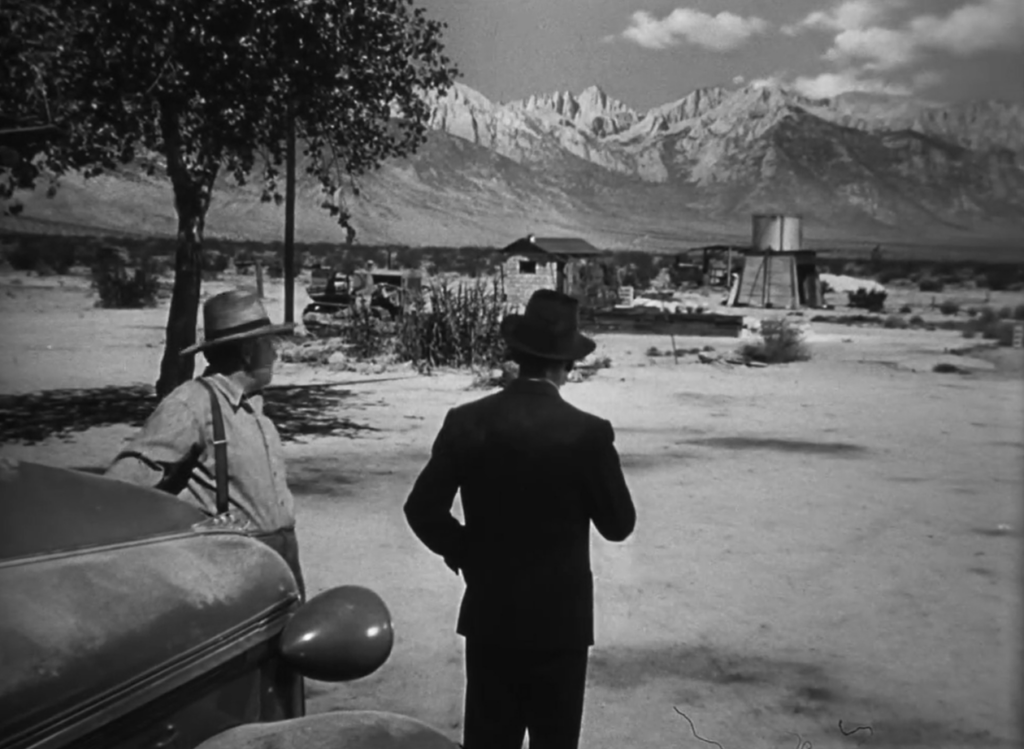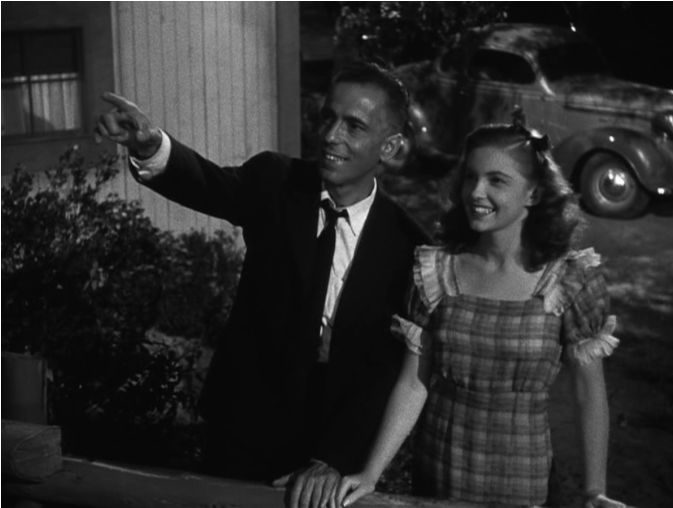| Ryan Sanderson |

High Sierra plays at the Trylon Cinema from Sunday, December 29th, through Tuesday, December 31st. Celebrate the New Year and visit trylon.org for tickets and more information.
Rushing Towards Death was the title W.R. Burnett originally wanted for High Sierra, the book that became the movie that made Humphrey Bogart into a movie star (and, more circuitously, John Huston into a director). That first—I would argue more evocative—title came from a favorite catchphrase of Depression-era bandit John Dillinger. In 1937 Burnett tried to make a Dillinger film with Warner Brothers, but public outcry and institutional backlash led to the project’s cancellation. Instead, Burnett used his research to write a novel about a former member of the Dillinger gang, released from prison on a pardon, forced to resume his old antisocial career in a much-changed 1940s America. The book explicitly states that Roy Earle (Bogart) was a member of Dillinger’s gang. The movie skirts past that detail, likely to avoid controversy.1
Earle is not Dillinger, but he is Dillinger’s Hollywoodized reflection. Like Dillinger, he grew up poor in the Midwest. Like Dillinger, he had a superficially stereotypical rural American upbringing, going to church, playing baseball, fishing down at the creek. Like Dillinger before his historic spree in 1934, Roy emerges from prison after almost a decade, ready to resume, even escalate, his life of crime.2 But Dillinger was a willfully cruel misanthrope. Whereas the movie goes to great lengths to show that despite his trained tough guy instincts, deep down Roy’s a softie. The book comparest them even more sharply. There’s a flashback in which Dillinger points out Roy to Big Mac (Donald Macbride), the man who ultimately gets Roy pardoned and coerces him into one last, doomed job: “You see that hick there with the big shoulders and the ugly face? Well, keep your baby-blue eyes on him. He’s folks.”3
The Production Code Administration effectively banned gangster movies in 1934.4 Studios responded by repackaging the formula, as culturally important histories like The Roaring Twenties, then eventually as artsier, innuendo-shielded film noirs, to keep the inherent subversive appeal without drawing public backlash. High Sierra is one such experiment. Its final scene in which Roy stands off with cops could be plucked straight out of Scarface, only it’s set on a mountain rather than in a worn down tenement. It evokes more comparisons to the western—which, I suspect, might be Burnett’s point. If the industry wouldn’t let him write a gangster film, he’d relocate it to show just how flimsy their standards truly were. How could it be a gangster movie if it’s called High Sierra?
W.R. Burnett effectively invented the gangster film a decade earlier. Given the rise of the criminal as a figure of national interest during the Depression, it was inevitable that Hollywood would eventually try to capitalize, but Burnett gave them the blueprint. His first novel and film, Little Caesar, may not be a perfect psychological study of Al Capone and his ilk, but it told their stories in a language the average moviegoer could relate to. Everyone from the censorship board to the local church temperance league knew that whatever tidy morals were appended to the opening credits or the final act denouement, the onscreen gangster was a vehicle for public discontent, used as a revenge fantasy by people who felt with significant justification that their society had failed them.5
The first gangster films were visceral, heavily moralized reflections of that discontent, in a country starving its citizens at the same moment it made booze illegal. The New Deal ultimately bailed out some Americans, but a great many, like Roy, became trapped in patterns that could not so easily reset. That’s the irony of Burnett’s original title. During both the book and film, Roy is trying to do anything but rush towards death. He dawdles in the park, waxes nostalgic about his childhood fishing, gets mixed up with a midwestern family moving to California. Roy knows the score, but he’s not eager to see his story completed. Nevertheless, he is rushing towards death, not with purpose but like someone being carried downriver against their will.
Roy is never idealized—he’s got real sharp edges, even brags about murder—but he’s almost always viewed sympathetically. Part of this is Burnett’s ethos. Part of it is director Raoul Walsh’s style, which film historian Dave Kehr described as, “that good old homegrown American existentialism: you are what you do.”6 The characters in the film are all technically criminals, but Marie Garson (Ida Lupino) is a smart, brave, earnest woman. She’s shacking up with killers out of necessity, because even men like Roy are an improvement on the world she came from. Roy doesn’t want to go through with the heist, but he’s also not willing to go back to prison. His actions make sense to me. From there, he’s swept along a path of inevitabilities all the way to his violent end.
The movie is fiercely loyal to the book. It makes sense, given Burnett co-wrote and Huston, his collaborator, frequently insisted he had no voice as a writer besides trying to bring out the essence of the projects he worked on.7 When a scene from the book is cut, they find some way to replace it in the movie. For instance, Roy has a conversation with a gas station attendant in both. In the book, Roy is rude to the attendant, who tries to displace the tension by insulting his own wife.8 In the movie, Bogart’s Roy is a little nicer to a wifeless attendant–part of the film’s effort to make him relatable—but the ugly domesticity has been moved a scene earlier, as Roy gets his mission from a corrupt ex-cop who yells and throws a book at his wife. In both cases, you get a pretty unpleasant glimpse of what Roy’s alternative sedentary life might have been. In this way, almost every scene in the book has some corollary in the film.
High Sierra is weirdly pivotal to Hollywood history. Huston agreed to write on the condition that, were it to succeed, he would be allowed to direct another adaptation of Dashiell Hammett’s The Maltese Falcon. The studio’s previous efforts to translate the book had been flops, so the stakes weren’t especially high. Jack Warner agreed.9 Warner did not want Humphrey Bogart for the lead role. The studio’s first choice was Scarface’s Paul Muni. According to Burnett, Muni dropped out after Huston drunkenly told him he was a lousy actor at a party.10 George Raft was also considered, but he was unwilling to die in the end.11 Even once Bogart was cast, the studio refused to give him top billing. That went to Ida Lupino, whose own rise to stardom came only a few months earlier in Raoul Walsh’s They Drive By Night (also featuring Bogart). Yet, High Sierra transformed Bogart into arguably the most iconic actor in Hollywood history.
In this way, High Sierra feels pitched between two eras of cinematic history much the same way that Roy Earle is trapped between the America of Herbert Hoover, where he took up a life of crime, and J. Edgar Hoover, where he was released. Burnett had been printing money for Hollywood for a decade. Director Raoul Walsh had been one of the industry’s most reliable journeymen since the early silent era. They were the major discoveries of the previous decades, in the same way their younger, even more legendary partners would come to define the next.
High Sierra is a strong representative of the moment when Hollywood crime films began to reflect on and rewrite their own legacy. Burnett’s choice to repackage Dillinger as something Hollywood-friendly already gives the project a metatextual layer, while Huston, Bogart, and Lupino all bring new insight and authenticity to their roles with the sharpness of a precocious child critiquing their parents. It’s not postmodern by Tarantino standards, but it knows much of its audience has seen this kind of story before, and occasionally it uses that exegetic baggage to draw comparisons, the same way Marie, Babe, and Red compare present-day Roy to the stories they heard about his heyday.
Gangsters themselves were far less relevant in 1941—something the film pokes fun at. Roy is not an allegorical recreation of some figure in the news, but one in a long line of avatars for the disillusionment, anger, and exhausted resignation a generation carried from that recent era when their society failed them. Note the film doesn’t begin with Roy or the Sierra Nevadas or even prison, but an American state house, and a governor signing a pardon obtained through corruption. The film wants us to begin by considering the promises of civic institutions, their potential for corruption, and the Depression–in that order. This progression of concepts–not a specific scene or bit of backstory–is our introduction to the world and mind of Roy Earle.

Initially, Roy falls pretty hard for the Goodhue family and their teenage granddaughter (ew). These are “good folks” who remind him of his childhood neighbors. This is an essential part of Roy’s psychology, the longing to go backward. But the film’s audience might also be inclined to view the genial Goodhues as some superior class of person to “Mad Dog” Roy Earle and poor, ruined Marie. When the film reveals in its final act that the Goodhues are naive, shallow, ordinary, and human, just like Roy and Marie, it feels like a reversal, not just of Roy’s expectations, but of the audience’s expectation that conventional morality should be wholly affirmed as a contrast to all the violence and vice.
In this sense, High Sierra feels more radical than any of the films that made the gangster movie so controversial. The film seems to sincerely posit that Marie and Roy are no different from the Goodhues, except by matters of pure luck and circumstance. Indeed, desperation has made them smarter, braver, and, in many ways, better. The leadup to the final tragedy suggests a middle ground might exist between wholly reintegrating into the Goodhues’ domestic world—something I doubt either could manage—and “rushing towards death.” One where Marie and Roy and Pard the dog run away together, share an unorthodox, comparatively stable, tolerable life. The movie cannot let them have that. Ultimately, they must be punished. But Marie can still stare directly past the camera as the film closes and wonder why.
Sympathy for tramps, gangsters, killers. Sympathy for John Dillinger. It would be unthinkable to make a gangster movie with those sentiments in 1941 Hollywood. Fortunately, High Sierra is not a gangster movie. It’s set in the mountains.
Works Cited
1 White, D. L. (2021). W. R. Burnett on High Sierra. The Criterion Channel. https://www.criterionchannel.com/videos/w-r-burnett
2 Toland, J. (2023). The Dillinger days. Open Road Integrated Media, Inc.
3 Burnett, W. R. (2022). High Sierra. Stark House Press.
4 Munby, J. (1999). Public enemies, public heroes : screening the gangster from Little Caesar to Touch of Evil. University of Chicago Press.
5 Mason, F. (2002). American gangster cinema : from Little Caesar to Pulp Fiction. Palgrave.
6 Kehr, D., & Nehme, F. S. (2021). Dave Kehr and Farran Smith Nehme on Raoul Walsh. The Criterion Channel. https://www.criterionchannel.com/videos/dave-kehr-and-farran-s mith-nehme-on-raoul-walsh
7 Huston, J., & Long, R. E. (2001). John Huston: interviews. University Press of Mississippi.
8 Burnett, W. R. (2022). High Sierra. Stark House Press.
9 Huston, J., & Long, R. E. (2001). John Huston : interviews. University Press of Mississippi.
10 White, D. L. (2021). W. R. Burnett on High Sierra. The Criterion Channel. https://www.criterionchannel.com/videos/w-r-burnett
11 Big Trail Productions. (2019). The True Adventures of Raoul Walsh. The Criterion Channel. Retrieved 2024, from https://www.criterionchannel.com/videos/the -true-adventures-of-raoul-walsh.
Edited by Olga Tchepikova-Treon
